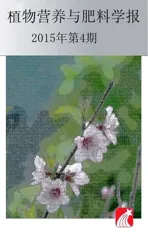钠钾替代对不同基因型棉花钾利用效率的影响
2015-06-12郝艳淑吴秀文姜存仓
雷 晶, 郝艳淑, 王 典, 吴秀文, 姜存仓
(华中农业大学资源与环境学院,农业部长江中下游耕地保育重点实验室,武汉 430070)
钠钾替代对不同基因型棉花钾利用效率的影响
雷 晶, 郝艳淑, 王 典, 吴秀文, 姜存仓*
(华中农业大学资源与环境学院,农业部长江中下游耕地保育重点实验室,武汉 430070)

棉花; 基因型; 钠钾替代; 钾利用效率
钾对植物的生长发育有重要的生理功能:促进光合作用及其产物的运输,促进蛋白质的合成,参与细胞渗透调节作用,调控气孔运动,激活酶的活性,促进有机酸代谢,增强植物的抗逆性[1]。而钾资源的短缺是我国乃至世界农业生产领域必须面临和解决的问题。土壤中钾资源潜力巨大,但生物有效性低,作物不能很好的吸收利用[2]。为缓解我国钾资源短缺的问题,刘国栋和刘更另提出了使用钾的替代物[3]。钠作为钾最大优势的替补阳离子,在缺钾情况下,加钠可以维持液泡的正常膨压,减少了缺钾造成渗透势变化的不利影响[4]。Cooper等[5]和Lancaster等[6]试验结果表明, 缺钾条件下施钠,能显著增加棉花茎叶和棉铃的干重,从而提高棉花产量。张彦才等[7]的研究结果表明,在土壤速效钾偏低的情况下,钠可以替代部分钾的作用,从而促进棉花的生长,提高棉花产量。因此,了解K+与Na+之间的替代作用和对植物的生理效应,对缓解钾肥资源短缺、提高钾效率有着重要的意义。当前,有关钠对于不同基因型棉花钾素替代作用的差异,以及钠是否有助于提高钾素的利用效率还需要进一步探讨。本研究主要通过营养液培养试验,研究钠钾替代作用对不同基因型棉花钾效率的影响,旨在为生产中科学利用钾肥提供依据。
1 材料与方法
1.1 试验材料和设计


1.2 取样及测定方法
培养30 d后将幼苗分根、茎、叶、柄取样,经105℃杀青30 min,70℃下烘干称重。样品粉碎后用马弗炉在500℃下进行干灰化,然后用0.1 mol/L的HCl浸提,火焰分光光度计测定钾和钠含量[12]。株高、根长采用直尺测量法;叶片数以完全展开的真叶数为准。
1.3 数据分析
相对生长速率(RGR)=(lnL2-lnL1)/(T2-T1)
式中: L2、 L1分别代表第二次和第一次测量时的根长和株高(间隔2周); T2、T1分别代表测量时间; ln为自然对数[13];
根冠比=根生物量/地上部生物量;
钾积累量=钾含量×干重[11];
钾利用效率=全株干重/全株钾积累量[11]。
用Microsoft Excel和Origin工具作图、 表分析,用SAS 9.1.3数据处理系统进行统计分析。
2 结果分析
2.1 不同钾水平下钠对不同钾效率基因型棉花农艺性状的影响
由表1可知,缺钾的条件下,施钠增加了103和122的根长和根长相对生长速率,其中103的根长和根长相对生长速率分别增加了11%和600%,122的分别增加了5%和55%,并且103和122的株高有所增加,但是株高的相对生长速率减少了。此外,显著增加了122的叶片数,而对103没有显著影响。适钾条件下施钠,103和122的根长有所增加,分别增加了16%和1%,但是根长的相对生长速率减少了。施钠显著增加了103株高和株高相对生长速率,122的则显著减少。因此,无论是否施钾、 施钠都能增加两个基因型的根长,且103增加的幅度大于122的。缺钾时施钠,两个基因型的根长相对生长速率显著增加;而适钾时施钠,则显著降低。方差分析结果表明(表1),基因型间、钾处理间和钠处理间差异均是极显著的;钾钠交互作用对根长和株高的相对增长速率有极显著的影响。
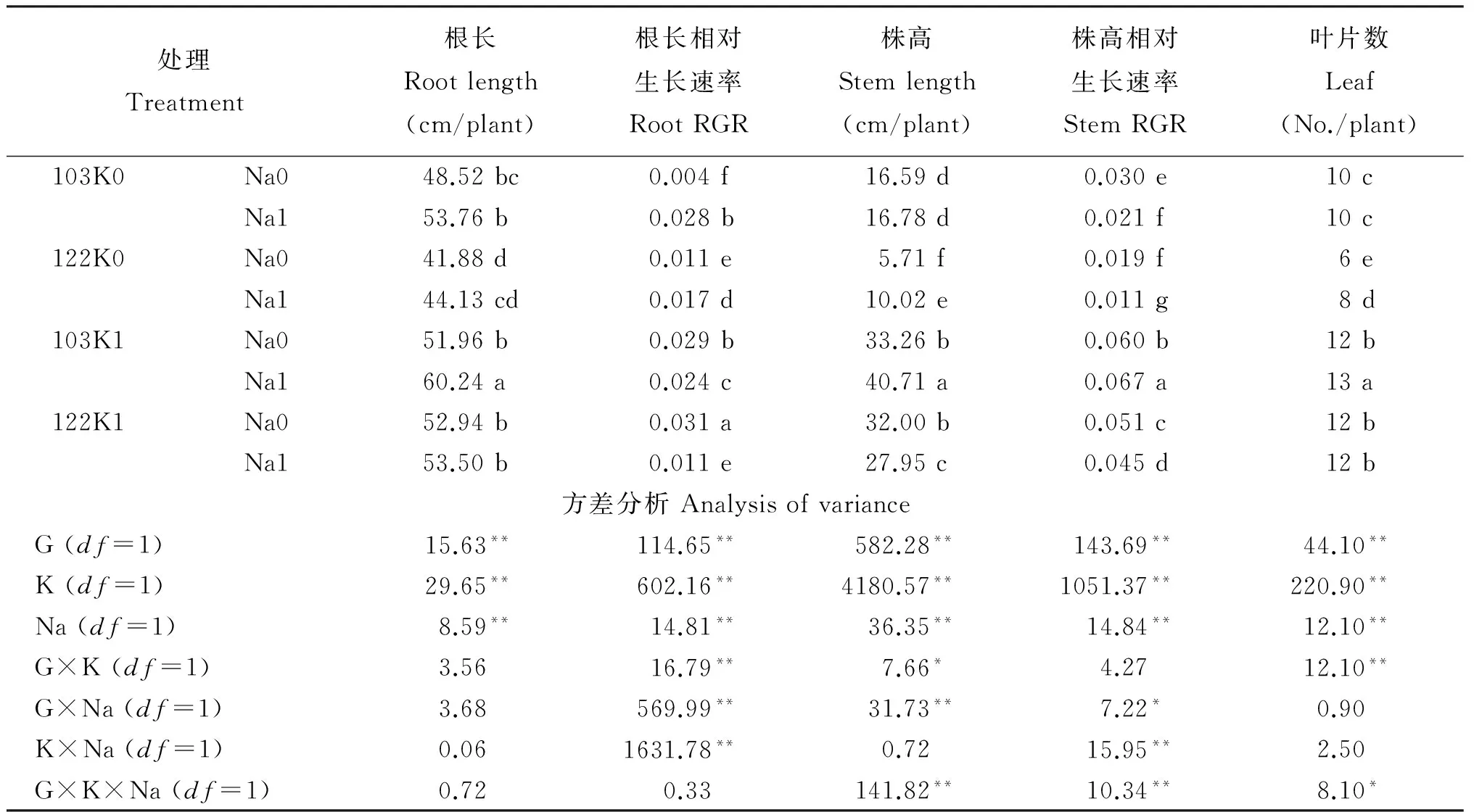
表1 钠对不同钾效率基因型棉花农艺性状的影响Table 1 Effect of sodium on agronomic traits of different cotton genotypes
注(Note): G—基因型Genotype; 数据后不同字母表示处理间差异达到5%显著水平Different letters mean significant at the 5% level. **,*分别表示显著性概率达到1%和5%(n=24) Indicate significant at the 1% and 5% levels(n=24).
2.2 不同钾水平下钠对不同钾效率基因型棉花各部位干重的影响
由表2可以看出,缺钾条件的施钠,103的根、茎、柄、总干重和根冠比都略有增加,但是没达到显著性水平,而122的地上部和总干重以及根冠比显著性增加了,分别增加了58%、65%和26%,其主要是由于叶干重显著增加45%。适钾的条件下,施钠能显著增加103和122的各部位干重和总干重。其中,103的根、地上部和总的干重分别增加了42%、 25%和29%,122的分别增加了35%、25%和28%。103和122的根冠比也分别显著增加了16%和9%。因而,适钾的条件下施钠能显著增加两个基因型各部位及总干重,且103的根冠比增加的幅度大于122的,主要是由于103的根干重的增加幅度大于122的。方差分析结果显示(表2),除了基因型对根冠比的影响不显著外,基因型、钾处理和钠处理对各部位干重、总干重和根冠比的影响均是极显著的;钾钠交互作用极显著的影响影响了各部位的干重和总的干重。
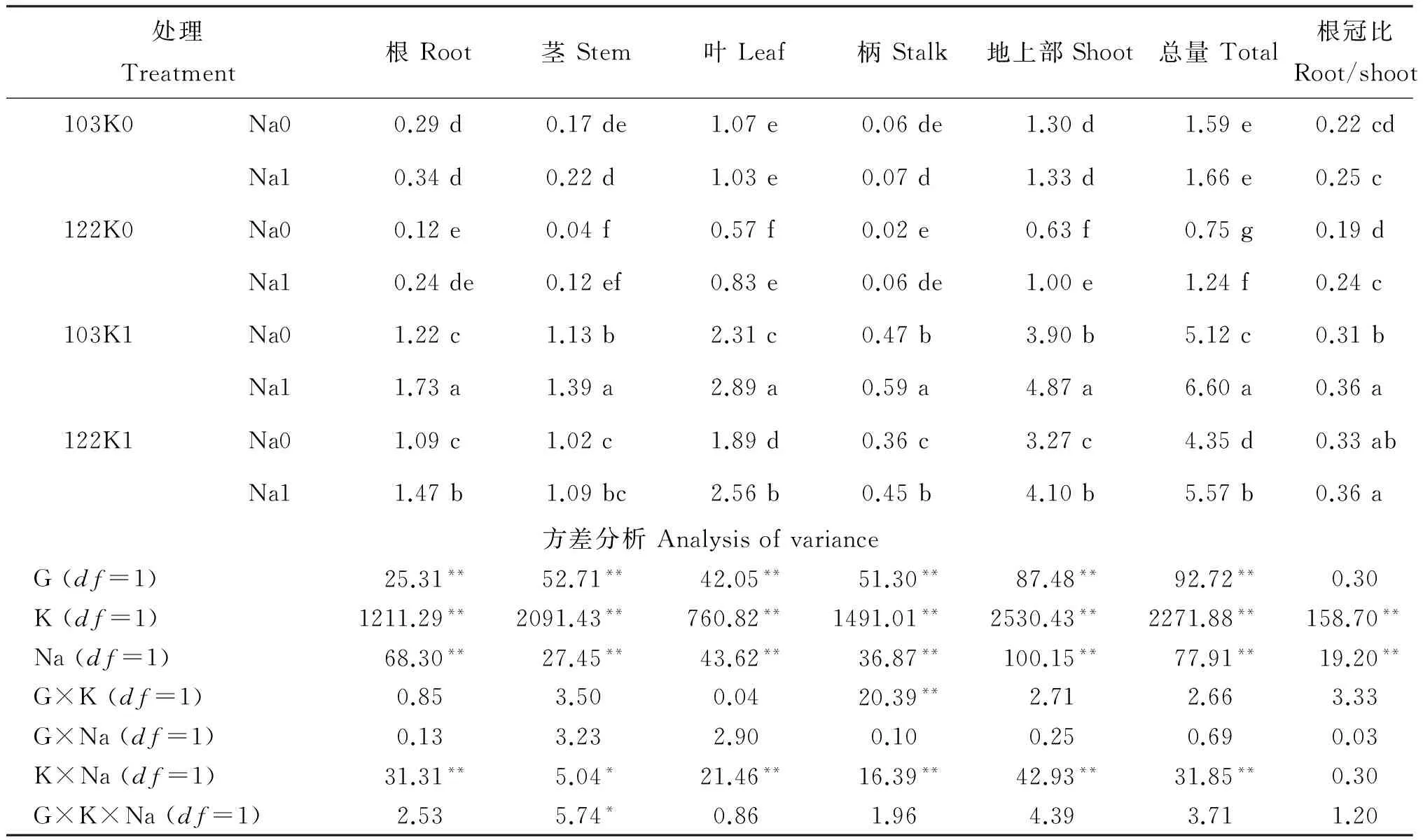
表2 钠对不同基因型棉花各部位干重的影响(g)Table 2 Effect of sodium on dry weights of different cotton genotypes
注(Note): G—基因型Genotype; 数值后不同字母表示处理间差异达到5%显著水平 Values followed by different letters mean significant at the 5% level. **,*分别表示显著性概率达到1%和5%(n=24) Indicate significant at the 1% and 5% levels(n=24).
2.3 不同钾水平下钠对不同钾效率基因型棉花各部位钾钠含量的影响
由表3可知,缺钾时,施钠显著降低了103和122根和茎的钾含量,其中103的分别降低了35%和43%,而122的降低了25%和45%,施钠对两个基因型叶柄中钾含量没有显著影响,各个部位钠含量都有大幅度显著增加。适钾时,施钠显著降低了103和122根和叶的钾含量,其中103的分别降低了14%和33%,122的则降低了19%和29%,各个部位钠含量也都有大幅度显著增加。因此,无论是否有钾,施钠后103和122两个基因型根的钠含量都显著增加,而钾含量都显著减少。且两个基因型钠含量增加的幅度和钾含量减小的幅度大致相同。方差分析表明(表3),除了基因型对叶中钾含量和钠处理对柄中钾含量没有显著影响外,基因型钾处理和钠处理对各部位钾钠含量的影响均是极显著的;钾钠交互作用对根、叶中的钾含量和各部位的钠含量有极显著的影响。
2.4 不同钾水平下钠对不同钾效率基因型棉花各部位钾钠积累量的影响
由表4可知,缺钾的条件下施钠,各部位和全株的钠积累量都显著增加,而对钾积累量没有显著影响。适钾的条件下施钠,各部位和全株的钠积累量都显著增加,除了叶片和柄中钾积累量稍微减少,其他各个部位的钾积累量都有不同程度的增加,说明钠能促进对钾的吸收。其中,103根中钾积累量显著增加了22%,而122的增加了10%,说明施钠能明显促进根系对钾的吸收,且对103的促进效果优于122。方差分析结果表明(表4),基因型对茎和叶中钾钠积累量,根和全株钠积累量有极显著的影响,钾处理对各部位和全株的钾钠积累量均有极显著影响,钠处理显著影响根、叶、柄中钾积累量和各部位的钠积累量;除了对茎和全株的钾积累量没有显著影响外,钾钠交互作用对其他各部位钾钠积累量均有显著的影响。
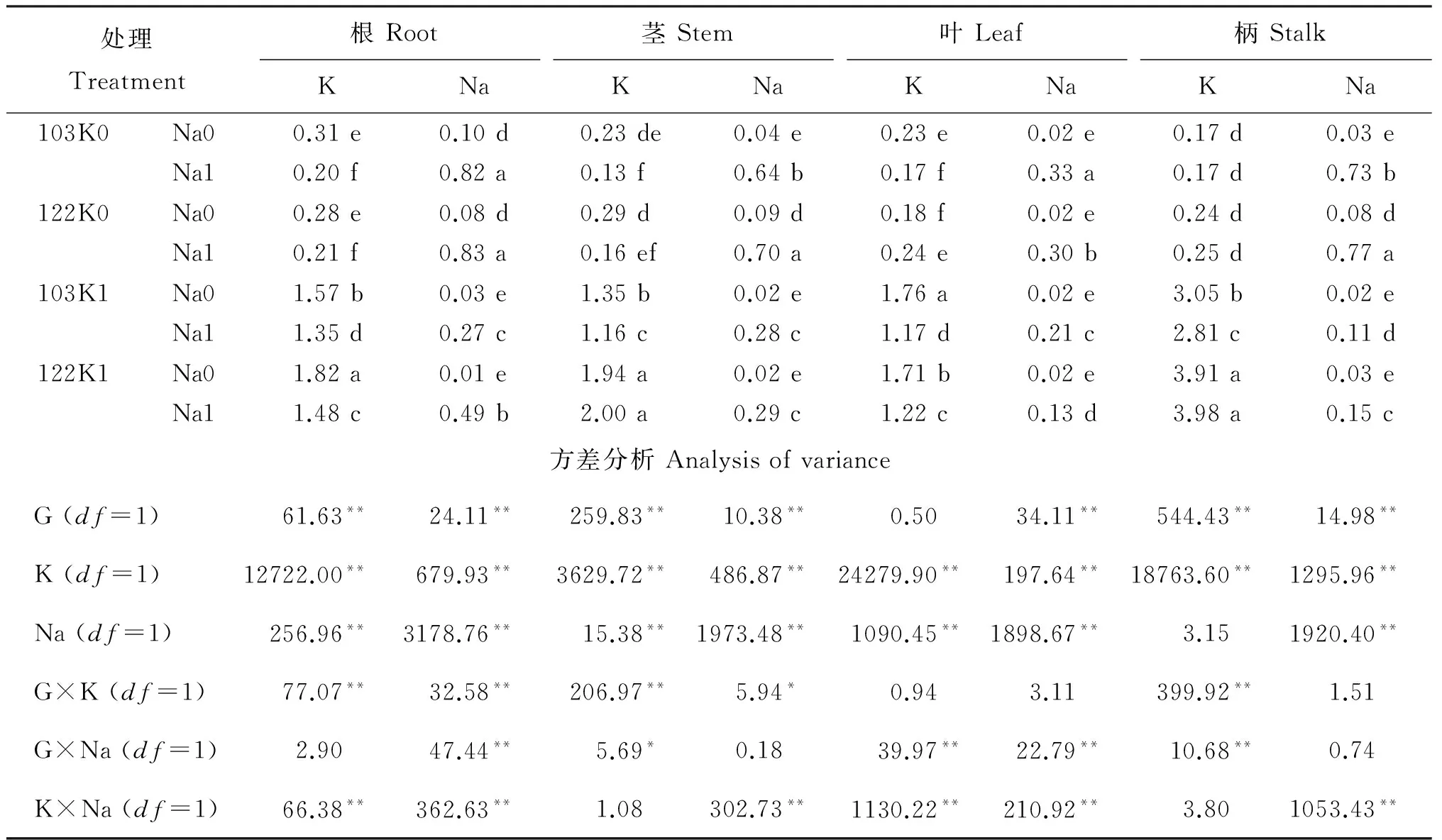
表3 钠对不同基因型棉花各部位钾钠含量的影响(%)Table 3 Effect of sodium on K and Na contents of different cotton genotypes
注(Note): G—基因型Genotype; 数据后不同字母表示处理间差异达到5%显著水平Values followed by different letters mean significant at the 5% level. **,*分别表示显著性概率达到1%和5%(n=24) Indicate significant at the 1% and 5% levels(n=24).
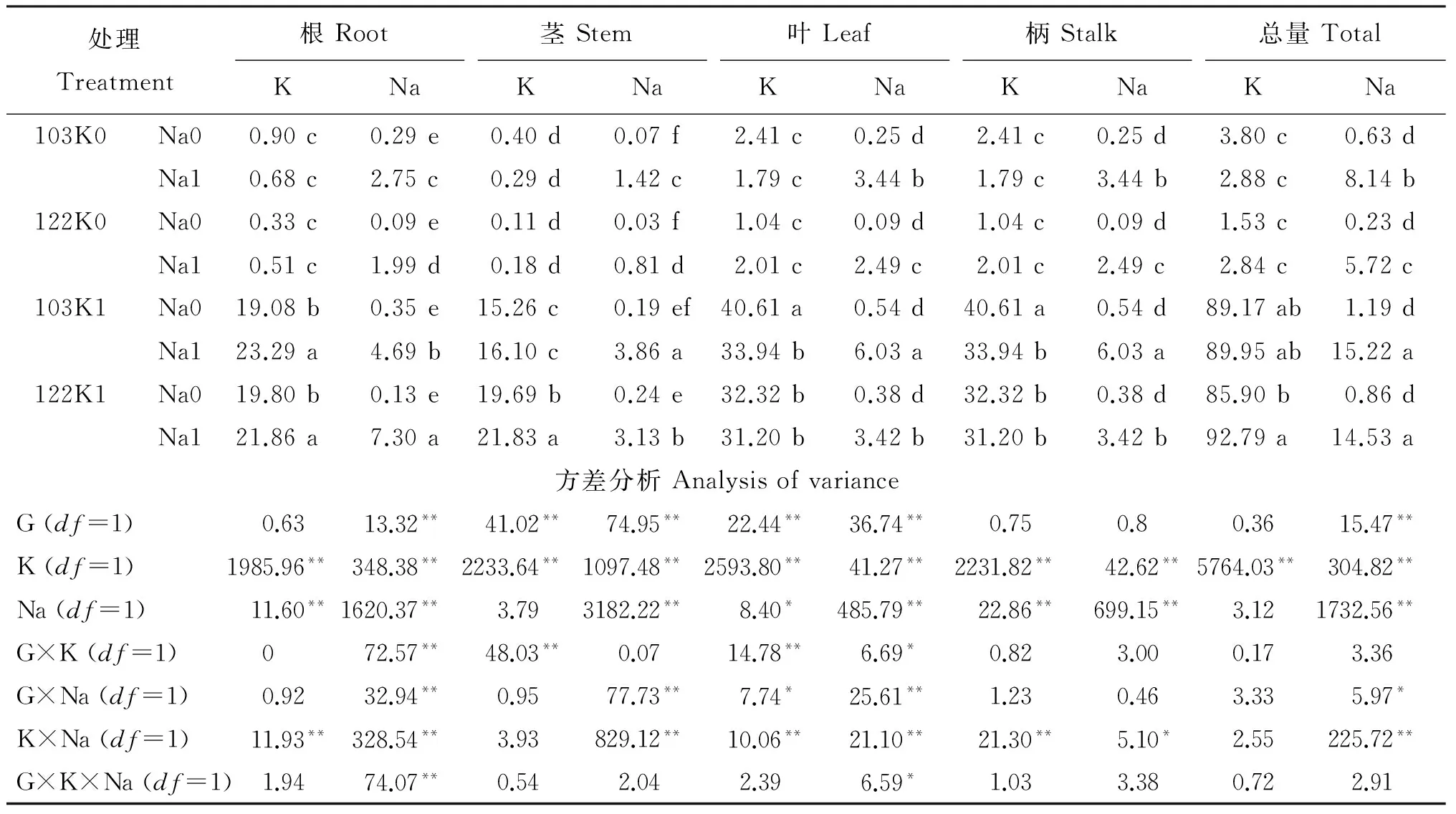
表4 钠对不同基因型棉花各部位钾钠积累量的影响(mg/plant)Table 4 Effect of sodium on K and Na accumulations of different cotton genotypes
注(Note): G—基因型Genotype; 数值后不同字母表示处理间差异达到5%显著水平Values followd by different letters mean significant at the 5% level. **,* 分别表示显著性概率达到1%和5%(n=24) Indicate significant at the 1% and 5% levels(n=24).
2.5 不同钾水平下钠对不同钾效率基因型棉花钾效率的影响
由图1可以看出,缺钾的条件下,施钠显著提高了103的钾利用效率,为缺钠条件下的1.37倍,而显著减少了122的钾利用效率。适钾条件下,施钠均有利于103和122的钾利用效率的增加,其中,高效基因型103的钾利用效率增加幅度为28%,而低效基因型122的增加幅度是19%。钾钠交互作用对钾利用效率有显著影响(FK×Na=6.52*),基因型、钾和钠间的交互作用也极显著地影响钾利用效率(FG×K×Na=41.50**)。
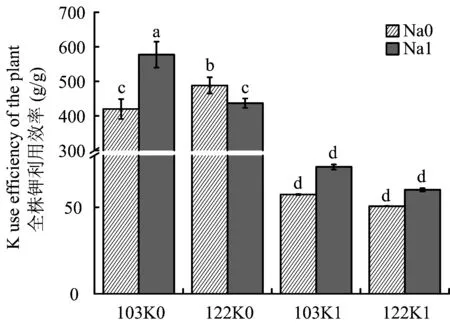
图1 钠对不同基因型棉花钾利用效率的影响Fig.1 Effect of sodium on K use efficiency of different cotton genotypes
3 讨论
本试验结果表明,缺钾的条件下施钠,103和122两个基因型的根和茎干重都没有显著增加,但是各部位钾的含量显著减少,钠含量显著增加,说明钠能部分而不能完全替代钾的功能。Zhang等[14]对棉花进行的盆栽试验结果表明,缺钾时施钠对棉花的总干重没有显著影响,陈国安[15]的试验结果也表明,低钾时加钠,茎叶中总钾量有所降低,而相应的由于钠的施用,钠则增加,与本试验结果一致。适钾的条件下,施钠能显著增加103和122各部位和总的干物重,同时各部位钾的含量有所减少,钠含量显著增加,说明钠可能部分替代钾行使钾非专性生理功能,使植物正常生长的需钾量减少[16]。刘国栋等[17]对不同基因型水稻钠对钾的部分替代作用的研究,也得到了相似的结论。彭春雪等的试验结果也表明,施钠能提高甜菜幼苗体内钠含量,增加干重,对其生长有促进作用[18]。吴春红等对小麦的研究结果表明适钾时施钠增加根系干重和根冠比[19],与本试验的结果相同。此外,适钾的情况下施钠,103根长增加的幅度(16%)大于122(1%)的,根干重增加幅度(42%)大于122(35%)的,根中钾积累量显著增加了22%,大于122的10%,说明施钠能明显促进根系的伸长、根系对钾的吸收,且对钾高效基因型103的促进效果优于钾低效基因型122。
施用钾肥能够降低盐碱地棉花地上部的钠含量,从而维持较高的K+/Na+来实现耐盐性[20]。施用钾肥可以促进体内盐分的排泄,增强植物耐盐胁迫的能力[21]。本研究也表明,适钠条件下施钾能显著降低各部位的钠含量,增加钾含量,从而提高K+/Na+。说明钾钠间的替代作用对减轻盐害和增强耐盐性有着重要的意义。
钾利用效率是指植物体内单位钾积累量所产生的干物质[22],其大小在一定程度上反映植株钾吸收利用能力的高低。本试验在缺钾的条件下施钠,103的钾利用效率显著提高。Ali等[23]的研究也表明,低钾时施钠能提高钾利用效率。适钾的条件下施钠,钾利用效率增加的幅度为103(28%)的大于122(19%)的,表明103对钾的吸收利用能力更强,因此可以认为103的钠钾替代作用更强,这也可能是103钾高效的机制之一[9]。
4 结论
无论是否施钾,施钠均能增加钾高效基因型103和钾低效基因型122棉花的根长,通过促进根系的伸长来提高棉花对钾的吸收和生物量的积累。在缺钾的条件下施钠,高效基因型103的钾利用效率显著提高,为缺钠条件的1.37倍。钾钠交互作用对钾效率的影响达到显著水平,基因型、钾和钠间的交互作用对钾效率的影响也达到极显著水平。适钾的条件下施钠,钾利用效率增加的幅度为103(28%)的大于122(19%)的,因此,高效基因型103的钠钾替代作用更强,这也可能是103钾高效的机制之一。
[1] 陆景陵. 植物营养学(第2版)[M]. 北京: 中国农业大学出版社, 2003. 50-58. Lu J L.Plant nutrition (2nd Edition)[M]. Beijing: China Agricultural University Press, 2003. 50-58.
[2] 严小龙, 张福锁. 植物营养遗传学[M]. 北京: 中国农业出版社, 1997. 1-17. Yan X L, Zhang F S. Plant nutrition genetics[M]. Beijing: China Agriculture Press, 1997. 1-17.
[3] 刘国栋, 刘更另. 论缓解我国钾源短缺问题的新对策[J]. 中国农业科学, 1995, 28 (1): 25-32. Liu G D, Liu G L. A new strategy alleviating shortage of potassium resource in China[J]. Scientia Agricultura Sinica, 1995, 28(1): 25-32.
[4] 姜理英, 杨肖娥, 石伟勇. 钾钠替代作用及对作物的生理效应[J]. 土壤通报, 2001, 32 (1): 28-31. Jiang L Y, Yang X E, Shi W Y. Potassium-sodium substitution and physiological effect of the substitution on crops[J]. Chinese Journal of Soil Science, 2001, 32(1): 28-31.
[5] Cooper H P, Garman W H. Effect of applications of sodium on the composition and yield of cotton at different levels of potash fertilization[CJ]. Soil Science Society of America Journal, 1943, 7: 331-338.
[6] Lancaster J D, Andrews W B, Jones U S. Influence of sodium on yield and quality of cotton lint and seed[J]. Soil Science, 1953, 76(1): 29-40.
[7] 张彦才, 周晓芬, 李巧云, 等. 钠替代部分钾对棉花生长和养分吸收的影响[J]. 植物营养与肥料学报, 2006, 12(1): 115-120. Zhang Y C, Zhou X F, Li Q Yetal. The effects of partial replacement of potassium by sodium on cotton growth and nutrition absorption[J]. Plant Nutrition and Fertilizer Science, 2006, 12(1): 115-120.
[8] 姜存仓, 袁利升, 王运华, 等. 不同棉花基因型苗期钾效率差异的初步研究[J]. 华中农业大学学报, 2003, 22(6): 564-568. Jiang C C, Yuan L L, Wang Y Hetal. K-efficiency in different cotton genotypes at seeding stage[J]. Journal of Huazhong Agricultural University, 2003, 22(6): 564-568.
[9] 姜存仓, 高祥照, 王运华, 等. 不同棉花基因型苗期钾效率差异及其机制的研究[J]. 植物营养与肥料学报, 2005, 11(6): 781-786. Jiang C C, Gao X Z, Wang Y Hetal. Potassium efficiency of various cotton genotypes and its nutritional mechanisms[J]. Plant Nutrition and Fertilizer Science, 2005, 11(6): 781-786.
[10] Joham H E. The calcium and potassium nutrition of cotton as influenced by sodium[J]. Plant Physiology, 1955, 30(1): 4-10.
[11] 郝艳淑, 姜存仓, 王晓丽, 等. 不同棉花基因型钾效率特征及其根系形态的差异[J]. 作物学报, 2011, 37(11): 2094-2098. Hao Y S, Jiang C C, Wang X Letal. Differences of potassium efficiency characteristics and root morphology between two cotton genotypes[J]. Acta Agronomica Sinica, 2011, 37(11): 2094-2098.
[12] 鲍士旦. 土壤农化分析(第三版)[M]. 在中国农业出版社, 2007. 270-271. Bao S D. Soil agro-chemistry analysis[M]. Beijing: China Agriculture Press, 2007. 270-271.
[13] 黄中文, 王伟, 徐新娟, 等. 大豆重组自交家系群体动态株高及其相对生长速率与产量的关系[J]. 作物学报, 2011, 37(3): 559-562. Huang Z W, Wang W, Xu X Jetal. Relationship of dynamic plant height and its relative growth rate with yield using recombinant inbred lines of soybean[J]. Acta Agronomica Sinica, 2011, 37(3): 559-562.
[14] Zhang Y C, Li Q Y, Zhou X Fetal. Effects of partial replacement of potassium by sodium on cotton seedling development and yield[J]. Journal of Plant Nutrition, 2006, 29(10): 1845-1854.
[15] 陈国安. 钠对棉花生长和钾的吸收与转移的影响[J]. 土壤, 2001, 33(3): 138-141. Chen G A. The effect of sodium on the growth, the potassium absorption and transfer of cotton[J]. Soils, 2001, 33(3): 138-141.
[16] Schubert S, Lauchi A. Na+exclusion, H+release, and growth of two different maize cultivars under NaCl salinity[J]. Plant Physiology, 1986, 126: 145-154.
[17] 刘国栋, 刘更另. 水稻不同基因型中Ca、 Na对K的部分替代作用[J]. 作物学报, 1996, 22(3): 313-319. Liu G D, Liu G L. The effects of partial replacement of potassium by sodium or calcium in Indica rice[J]. Acta Agronomica Sinica, 1996, 22(3): 313-319.
[18] 彭春雪, 耿贵, 於丽华, 等. 不同浓度钠对甜菜生长及生理特性的影响[J]. 植物营养与肥料学报, 2014, 20(2): 459-465. Peng C X, Geng G, Yu L Hetal. Effects of different Na+concentrations on the growth and physiological traits of sugar beet[J]. Journal of Plant Nutrition and Fertilizer, 2014, 20(2): 459-465.
[19] 吴春红, 梁雪, 李斯深, 等. 小麦苗期钾、钠吸收相关性状及其QTL 分析[J]. 植物营养与肥料学报, 2013, 19(5): 1025-1036. Wu C H, Liang X, Li S Setal. Potassium and sodium absorption related traits and QTL mapping at the seedling stage of wheat[J]. Journal of Plant Nutrition and Fertilizer, 2013, 19(5): 1025-1036.
[20] 董合忠. 盐碱地棉花栽培学[M]. 北京: 科学出版社, 2010. 84-86. Dong H Z. Cotton cultivation in saline soil[M]. Beijing: Science Press, 2010. 84-86.
[21] 代建龙, 董合忠, 段留生. 棉花盐害的控制技术及其机理[J]. 棉花学报, 2010, 22(5): 486-494. Dai J L, Dong H Z, Duan L S. Technology and mechanism in control of salt injury in cotton[J]. Cotton Science, 2010, 22(5): 484-494.
[22] Rengel Z, Damon P M. Crops and genotypes differ in efficiency of potassium uptake and use[J]. Physiologia Plantarum, 2008, 133(4): 624-636.
[23] Ali L, Rahmatullah M, Maqsood M Aetal. Potassium substitution by sodium in root medium influencing growth behavior and potassium efficiency in cotton genotypes[J]. Journal of Plant Nutrition, 2009, 32(10): 1657-1673.
Substitution effect of sodium and potassium on potassium use efficiency of different cotton genotypes
LEI Jing, HAO Yan-shu, WANG Dian, WU Xiu-wen, JIANG Cun-cang*
[CollegeofResourcesandEnvironmentalScience,HuazhongAgriculturalUniversity/KeyLaboratoryofArableLandConservation(MiddleandLowerReachesofYangtseRiver),MinistryofAgriculture,Wuhan430070,China]
【Objectives】Potassium (K) is one of the important nutritional elements, and is necessary for plant growth and development. While proportion of bioavailabe K in soil K pool is relatively low and it is difficult for crop to effectively use, and shortage of K resources is a problem that the world needs to solve. K deficiency can affect cotton growth but sodium(Na) can share some physiological functions with K, so studying synergistic and substitution effects of Na and K is an effective way to improve the crop K efficiency. In this research, a solution experiment was conducted to study the substitution effects of Na and K on K use efficiency of two typical K-efficiency cotton genotypes, and to provide scientific and rational use of potash in the production process.【Methods】 To study the agronomic traits(root length, stem length and leaf numbers), dry weights, K and Na contents, K and Na accumulation and distribution in plant organs respectively and to explore the substitution effects of Na and K on K use efficiency of two typical K-efficiency cotton genotypes, a hydroponics experiment was conducted with different K and Na treatments in Huazhong Agricultural University. 【Results】 In deficient K, Na can increase the root lengths of both genotypes, and the increase amplitude in cultivar 103 is higher than in cultivar 122. The dry weights of each part of 103 and 122 are increased by the Na application. The K contents in both the roots and stems of 103 and 122 are also reduced, but the difference in the K accumulation between the two cultivars is not significant. Na application significantly improves the whole plant K use efficiency of 103, which is about 1.37 times of that under the lack of sodium. In adequate K condition, Na could also increase the root lengths of both genotypes, and the dry weights of each part of both genotypes are significantly increased. Meanwhile, the K content in roots and leaves is significantly reduced, the K accumulation amounts in all the parts except for leaves and stalks are increased in different degrees. When K is adequate, Na is beneficial to the increase of K use efficiency in 103 and 122, and the increase in 103 is 28%, which is higher than that in 122 (19%). Meanwhile, significant and positive interaction between K and Na is showed on the relative growth rates of roots and stems, the dry weights of all the parts, the K and Na contents and the accumulations in roots and leaves and the whole plant K use efficiency. 【Conclusions】 The root lengths under the addition of Na in deficient or adequate K are significantly enhanced by promoting root elongation to raise the absorption of K and biomass accumulation. In deficient K, Na could significantly improve K use efficiency of 103, while with the addition of Na in adequate K, the increase amplitude of K use efficiency of 103 is higher than that of 122. These results show that 103 has better K and Na replacement and synergistic effect.
cotton; genotype; sodium and potassium replacement; K use efficiency
2014-05-22 接受日期: 2014-10-25
国家自然科学基金(40801112); 公益性行业(农业)科研专项(201203013)资助。
雷晶 (1989—), 女, 湖北武汉人, 硕士研究生, 主要从事植物养分资源高效机理研究。 E-mail: lj7202@126.com * 通信作者 E-mail: jcc2000@mail.hzau.edu.cn
S562.062
A
1008-505X(2015)04-0962-07
